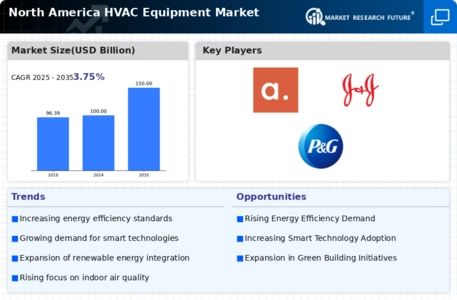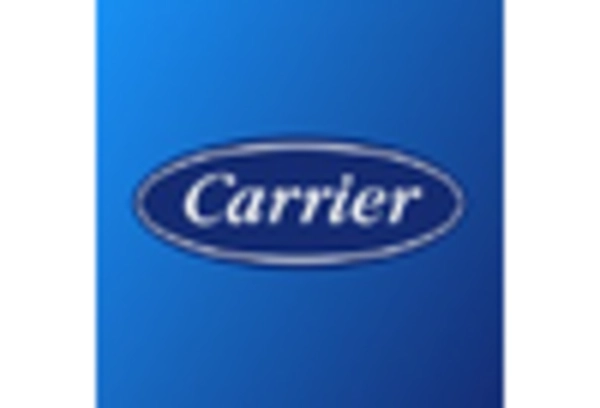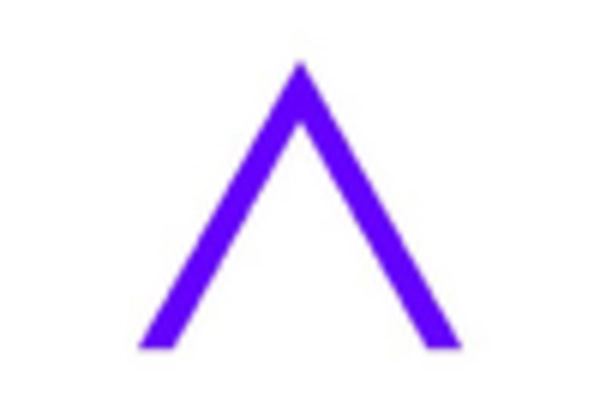Regulatory Compliance and Standards
Regulatory compliance is becoming an essential driver in the North America HVAC Equipment Market. Governments at various levels are implementing stringent regulations aimed at improving energy efficiency and reducing greenhouse gas emissions. The U.S. Department of Energy has established efficiency standards that HVAC systems must meet, which has led to increased demand for compliant equipment. Manufacturers are compelled to innovate and adapt their products to meet these evolving standards, which can create opportunities for growth within the market. Additionally, as states and municipalities adopt their own regulations, the need for compliant HVAC solutions is likely to rise. This regulatory landscape is expected to shape the future of the North America HVAC Equipment Market, driving both innovation and market expansion.
Increased Focus on Indoor Air Quality
The North America HVAC Equipment Market is witnessing a heightened focus on indoor air quality (IAQ), driven by growing health concerns among consumers. Poor indoor air quality has been linked to various health issues, prompting both residential and commercial sectors to prioritize air quality improvements. The U.S. Environmental Protection Agency emphasizes that effective HVAC systems can significantly enhance IAQ by filtering pollutants and controlling humidity levels. As a result, there is a rising demand for HVAC systems equipped with advanced filtration technologies and air purification features. Market data indicates that the IAQ segment is expected to grow at a compound annual growth rate of 8% over the next five years. This increasing emphasis on IAQ is likely to be a pivotal driver in the North America HVAC Equipment Market.
Technological Advancements in HVAC Systems
Technological advancements are significantly influencing the North America HVAC Equipment Market. Innovations such as variable refrigerant flow systems, smart thermostats, and IoT-enabled devices are transforming traditional HVAC systems into more efficient and user-friendly solutions. The integration of smart technology allows for real-time monitoring and control, which can lead to substantial energy savings. According to the U.S. Energy Information Administration, the adoption of smart HVAC technologies is expected to increase by 25% over the next five years. This trend not only enhances operational efficiency but also improves user experience, making HVAC systems more appealing to consumers. As technology continues to evolve, it is anticipated that the North America HVAC Equipment Market will witness a surge in demand for these advanced systems.
Rising Demand for Energy-Efficient Solutions
The North America HVAC Equipment Market is experiencing a notable shift towards energy-efficient solutions. This trend is largely driven by increasing energy costs and heightened awareness of environmental sustainability. According to the U.S. Department of Energy, energy-efficient HVAC systems can reduce energy consumption by up to 30%. As consumers and businesses alike seek to lower their energy bills and carbon footprints, manufacturers are responding by developing advanced technologies that enhance efficiency. The market is projected to grow as regulatory frameworks increasingly mandate energy efficiency standards, compelling both residential and commercial sectors to upgrade their HVAC systems. This growing demand for energy-efficient solutions is likely to be a key driver in shaping the future landscape of the North America HVAC Equipment Market.
Growth in Construction and Renovation Activities
The North America HVAC Equipment Market is poised for growth due to an upsurge in construction and renovation activities. As urbanization continues to rise, there is an increasing demand for new residential and commercial buildings, which necessitates the installation of HVAC systems. According to the U.S. Census Bureau, construction spending in the residential sector has seen a steady increase, indicating a robust market for HVAC equipment. Furthermore, renovation projects often require upgrades to existing HVAC systems to meet modern efficiency standards and improve comfort levels. This trend is likely to drive demand for advanced HVAC solutions, as builders and homeowners seek to incorporate the latest technologies. The growth in construction and renovation activities is expected to be a significant driver in the North America HVAC Equipment Market.


















Leave a Comment